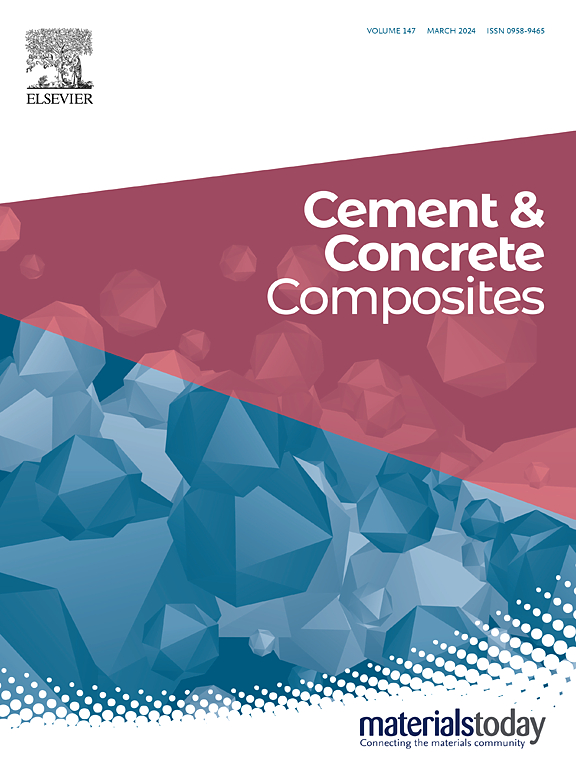Mesoscale degradation of interface transition zone in recycled aggregate concrete under multi-ion attack: Role of cementitious composites and microhardness-geometric evolution
IF 13.1
1区 工程技术
Q1 CONSTRUCTION & BUILDING TECHNOLOGY
引用次数: 0
Abstract
This study investigates the microhardness and geometric degradation mechanisms of interfacial transition zones (ITZs) in recycled aggregate concrete (RAC) exposed to saline soil attack, focusing on the influence of supplementary cementitious materials (SCMs). Ten RAC mixtures incorporating fly ash (FA), granulated blast furnace slag (GBFS), silica fume (SF), and metakaolin (MK) at 10 %, 15 %, and 20 % replacement ratios were subjected to 180 dry-wet cycles in a 7.5 %MgSO4-7.5 %Na2SO4-5 %NaCl solution. Key results reveal that ITZ's microhardness and geometric degradation decreases with exposure depth but intensifies with prolonged dry-wet cycles. The FA-GBFS synergistically enhances ITZ microhardness while minimizing geometric deterioration, with ITZ's width and porosity reduced to 67.6–69.0 μm and 25.83 %, respectively. In contrast, FA-SF and FA-MK exacerbate microhardness degradation, increasing porosity and amplifying microcrack coalescence. FA-GBFS mitigates the "diffusion-leaching” of aggressive/original ions and suppresses the formation of corrosion products, thereby inhibiting the initiation and propagation of microcracks. In contrast, FA-SF and FA-MK promote the formation of ettringite/gypsum and crystallization blöedite/glauberite, which facilitates the formation of "trunk-limb-twig” cracks.
多离子侵蚀下再生骨料混凝土界面过渡区的中尺度降解:胶凝复合材料和显微硬度-几何演化的作用
本文研究了受盐渍土侵蚀的再生骨料混凝土(RAC)界面过渡区(ITZs)的显微硬度和几何降解机制,重点研究了补充胶凝材料(SCMs)的影响。在7.5%MgSO4-7.5%Na2SO4-5%NaCl溶液中,以10%、15%和20%的替代率分别加入粉煤灰(FA)、颗粒状高炉渣(GBFS)、硅灰(SF)和中高岭土(MK)的10种RAC混合物进行了180次干湿循环。关键结果表明,ITZ的显微硬度和几何退化随暴露深度的增加而降低,但随干湿循环时间的延长而加剧。FA-GBFS协同提高了ITZ显微硬度,同时最大限度地减少了几何劣化,ITZ的宽度和孔隙率分别降低到67.6 ~ 69.0 μm和25.83%。相反,FA-SF和FA-MK加剧了显微硬度的退化,增加了孔隙率,放大了微裂纹的合并。FA-GBFS减缓了侵蚀性/原生离子的“扩散浸出”,抑制了腐蚀产物的形成,从而抑制了微裂纹的萌生和扩展。而FA-SF和FA-MK则促进钙矾石/石膏的形成和blöedite/青光石的结晶,有利于“干-枝-细枝”裂纹的形成。
本文章由计算机程序翻译,如有差异,请以英文原文为准。
求助全文
约1分钟内获得全文
求助全文
来源期刊

Cement & concrete composites
工程技术-材料科学:复合
CiteScore
18.70
自引率
11.40%
发文量
459
审稿时长
65 days
期刊介绍:
Cement & concrete composites focuses on advancements in cement-concrete composite technology and the production, use, and performance of cement-based construction materials. It covers a wide range of materials, including fiber-reinforced composites, polymer composites, ferrocement, and those incorporating special aggregates or waste materials. Major themes include microstructure, material properties, testing, durability, mechanics, modeling, design, fabrication, and practical applications. The journal welcomes papers on structural behavior, field studies, repair and maintenance, serviceability, and sustainability. It aims to enhance understanding, provide a platform for unconventional materials, promote low-cost energy-saving materials, and bridge the gap between materials science, engineering, and construction. Special issues on emerging topics are also published to encourage collaboration between materials scientists, engineers, designers, and fabricators.
 求助内容:
求助内容: 应助结果提醒方式:
应助结果提醒方式:


